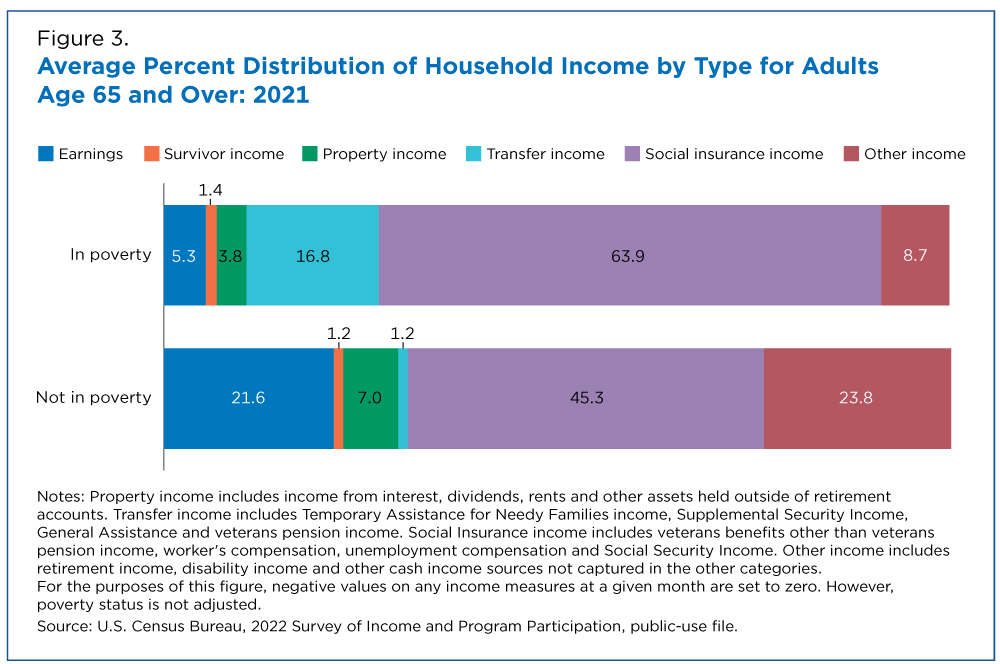Older Adults in Poverty Less Likely Than Those Not in Poverty to Live in Households that Receive Social Security
Many older adults rely heavily on Social Security, the largest anti-poverty program in the United States, and research shows it was the sole source of income for 28% of adult recipients in 2021.
In 2021, most (63%) older adults in poverty lived alone compared to only 26% of those not in poverty.
But not all older adults get Social Security benefits, for reasons such as insufficient or no work history. In 2021, older adults — defined here as those age 65 and over — who were living in poverty were less likely than their counterparts not in poverty to receive income from programs such as Social Security.
What are the characteristics and living arrangements of these older adults in poverty — and what income sources do they rely on to make ends meet?
A U.S. Census Bureau report published today uses data from the Survey of Income and Program Participation (SIPP) to draw a profile of the 4.7 million older adults who lived in poverty in 2021.
The SIPP provides comprehensive information on the dynamics of income, employment, household composition and government program participation.
Who Are the Older Adults Living in Poverty?
In 2021, roughly 8% of the nation’s population age 65 and over lived in poverty. These older adults had different demographic and social characteristics than adults in this age group who were not in poverty.
As shown in Figure 1, women made up a larger share of the older adult population in poverty (65%) than of the older population not in poverty (54%).
Different family and work experiences and longer life expectancies may contribute to greater economic challenges for women in their later years.
Race and Ethnicity
Older adults living in poverty were more likely to be Hispanic (20%) or non-Hispanic Black (17%) than their counterparts not in poverty (8% and 9%, respectively).
By contrast, older adults living in poverty were less likely to be non-Hispanic White (55%) than those not in poverty (77%).
These findings reflect the way in which lifetime earnings differences by race [PDF <1.0 MB] and ethnicity may manifest itself in economic challenges later in life.
Living Arrangements
Older adults in poverty were significantly less likely to be married in 2021 (24%) than those not in poverty (59%). This may be because some financial programs, tax benefits and other nontax benefits are not available to unmarried individuals, including those who are never married, divorced or widowed.
In 2021, most (63%) older adults in poverty lived alone compared to only 26% of those not in poverty.
A variety of factors from personal preferences and life experiences to the financial burden of living alone may influence older adults’ living arrangements.
Social Security and Old-Age Safety Net
What sources of income do older adults in poverty rely on and how do they differ from those not in poverty?
Aside from Medicare, Social Security is the most common federal benefit among adults age 65 and over.
But in 2021 only about 70% of older adults in poverty lived in households that received Social Security, compared to about 91% of those in households not in poverty (Figure 2).
This indicates that while Social Security helps lift a large number of people age 65 and over out of poverty, many Social Security recipients remain poor.
However, a larger share of older adults in poverty lived in households that received Supplemental Security Income (SSI) compared to the share of older adults not living in poverty.
Additionally, older adults in poverty were much less likely to receive retirement income (14% compared to 64%), property income (24% compared to 67%) and earnings (9% compared to 41%) than those not in poverty.
Even though older adults in poverty lived in households less likely to receive Social Security, their households, on average, still drew roughly two-thirds of their income from social insurance programs, including Social Security and other programs such as certain Veterans Administration benefits (Figure 3).
In 2021, people age 65 and over in poverty lived in households that received a much smaller share of their income than those not in poverty from sources like earnings, property income (including interest) and other income (including retirement) than those not in poverty.
The data show that while those living in poverty were less likely to receive Social Security, it remained a particularly important income source for the households that did receive it.
Other Benefits
Older adults in poor households in 2021 also received non-cash benefits to a greater extent than those above the poverty line:
- 44% of those in poverty and 8% of those not in poverty lived in households that received Supplemental Nutrition Assistance Program (SNAP) benefits.
- 16% of those in poverty and 4% not in poverty lived in households that received transportation assistance.
- 20% of those in poverty and 5% not in poverty lived in households that received forms of food assistance other than SNAP.
The Census Bureau previously found that roughly half of older adults receiving needs-based assistance received more than one type, indicating that Social Security benefits are not a sufficient safety net for people who have to piece together income from multiple sources to make ends meet.
A Census Bureau data visualization allows users to explore patterns of overlapping receipt between different social safety net programs across sociodemographic groups, including the large overlap between receipt of Social Security and receipt of Medicare.
More information on participation in social safety net programs is available in fact sheets, detailed program participation tables, interactive data visualizations and reports.
Related Statistics
Subscribe
Our email newsletter is sent out on the day we publish a story. Get an alert directly in your inbox to read, share and blog about our newest stories.
Contact our Public Information Office for media inquiries or interviews.
-
Families and Living ArrangementsHome Alone: More Than A Quarter of All Households Have One PersonIn 2020, 27.6% of occupied U.S. households had one person living alone, about 20 percentage points higher than in 1940.
-
PopulationAn Aging U.S. Population With Fewer Children in 2020The age profiles of states and communities don’t always mirror the national picture.
-
PopulationWhat Happens When Older Adults Struggle to Make Ends Meet?The packages of needs-based assistance that some older adults rely on may indicate difficulty affording health care, food, shelter and other necessities.









